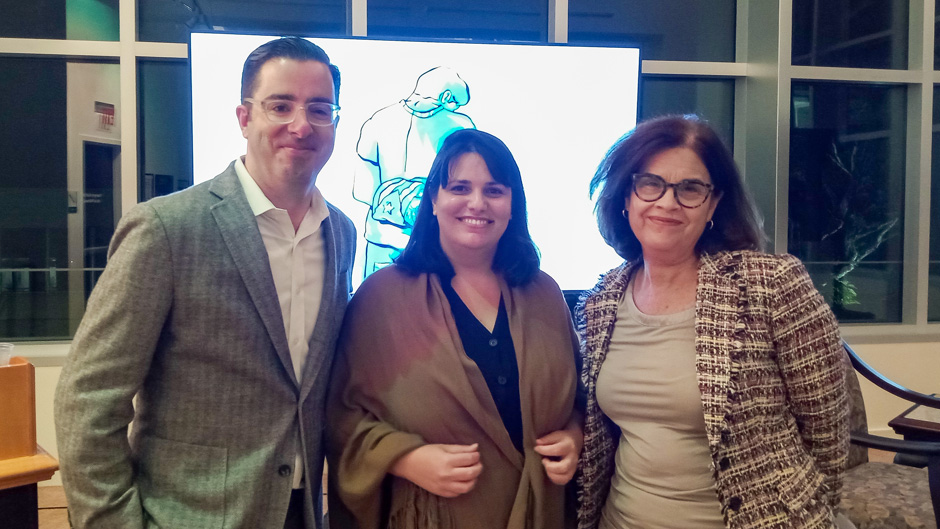With more Cubans having greater access to the internet via VPNs, news and information is still trickling in and out of the Caribbean island.
Elaine Diaz, a visiting professor at the University of Miami School of Communication and the first Cuban from the island to receive a Nieman Fellowship to study at Harvard University, spoke at the discussion “Voices for Change: The Rise of Independent Journalism in Cuba” at the Roberto C. Goizueta Pavilion in the Otto G. Richter Library about her contributions to creating space for local reporting in the country.
Michael Bustamante, associate professor of history and Emilio Bacardí Moreau Chair in Cuban and Cuban-American Studies in the College of Arts and Sciences, and Sallie Hughes, associate dean for global initiatives at the School of Communication, joined Diaz in the discussion of how this independent journalism is generating change on the island, as well as how it was able to come to fruition.
“Even though the systems of government are so different between the U.S. and Cuba, you have to work in Cuba as if you’re working in America,” said Diaz. “You have to act like the freedom of speech and democratization of storytelling is there in Cuba so you can approach stories with no fear.”

According to Diaz, this can be done by keeping several important elements in mind—prioritizing audience-driven stories, basing stories on verifiable facts, transparency, a good business model, and collaboration between peers. This is what the visiting professor does in her own independent journalism startup, Periodismo del Barrio, a digital platform that centers the stories of Cuban locals and communities through feature and narrative writing.
While studying journalism at Harvard in 2015, Diaz learned of the disastrous earthquake that took place in Nepal, but also noticed that extended coverage of the devastating recent floods in her home country of Cuba was being overlooked, specifically because of the lack of access to information on the island.
Though she had very little money at the time, she decided to start telling the stories of Cuban locals on the ground—so she bought a domain name for her new platform and got to work.
“I didn’t really have any money at the time to sustain a bigger platform, but we sent out applications for people to join our team and were overwhelmed with the response,” Diaz explained. “The July 11 protests [where thousands of Cubans took to the streets to protest lack of food, medicine and civil rights] were also a major turning point for us because the level of readership and commitment just blew up.”
At the event held last Thursday at the Cuban Heritage Collection, Diaz went on to speak about the sustainability of local news outlets such as hers, both on a financial level and emotional level. When taking on an independent initiative for change, especially under the Cuban government as Diaz explained, a strong infrastructure and business model are needed to maintain the effort’s longevity.
According to Diaz, this includes everything from subscriptions, crowdsourcing, and in the case of Periodismo del Barrio, working with international journalists to learn about more creative ways to tell stories.
Often in Cuba, journalists are harassed, threatened, interrogated, and even imprisoned by the government in an effort to silence dissent. To combat this in her own way, Diaz shared that Periodismo del Barrio uses several tactics. These include making sure journalists are not alone while covering stories, limiting them to only a few days at these sites, and employing international therapists and psychologists ready to help the Cuban communicators.
“We also try to be ‘invisible’ as journalists,” Diaz said. “We want audience-driven stories, so we embed ourselves in the community as much as we can by helping in a situation where help is needed. That way, we also gain the trust of the people to tell us their stories as if we were family, because in a way, we are.”
Though the presence of a strict Cuban government still looms large over the island, Diaz noted that efforts such as hers are a way of making small but meaningful changes for the locals as they continue to hope for bigger governmental changes.
“As Cubans are waiting for their chance at freedom of speech and all the other freedoms that come with democracy, they’re also waiting for food and water,” said Diaz. “If we can help in any little way, and if we can as journalists get these small changes in the community—whether it’s bringing attention to a natural disaster, climate change, or human rights—then we’re doing our job.”

